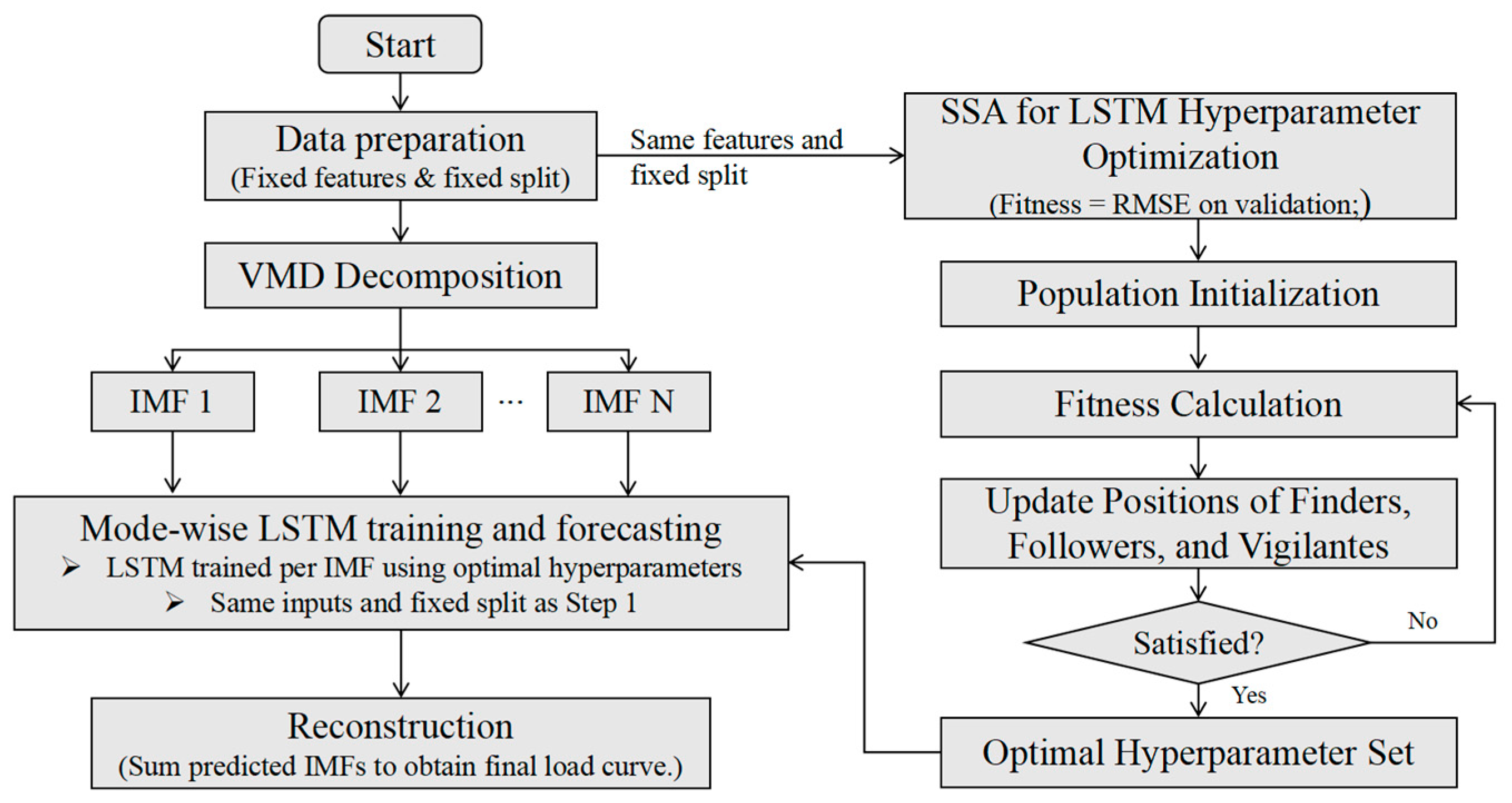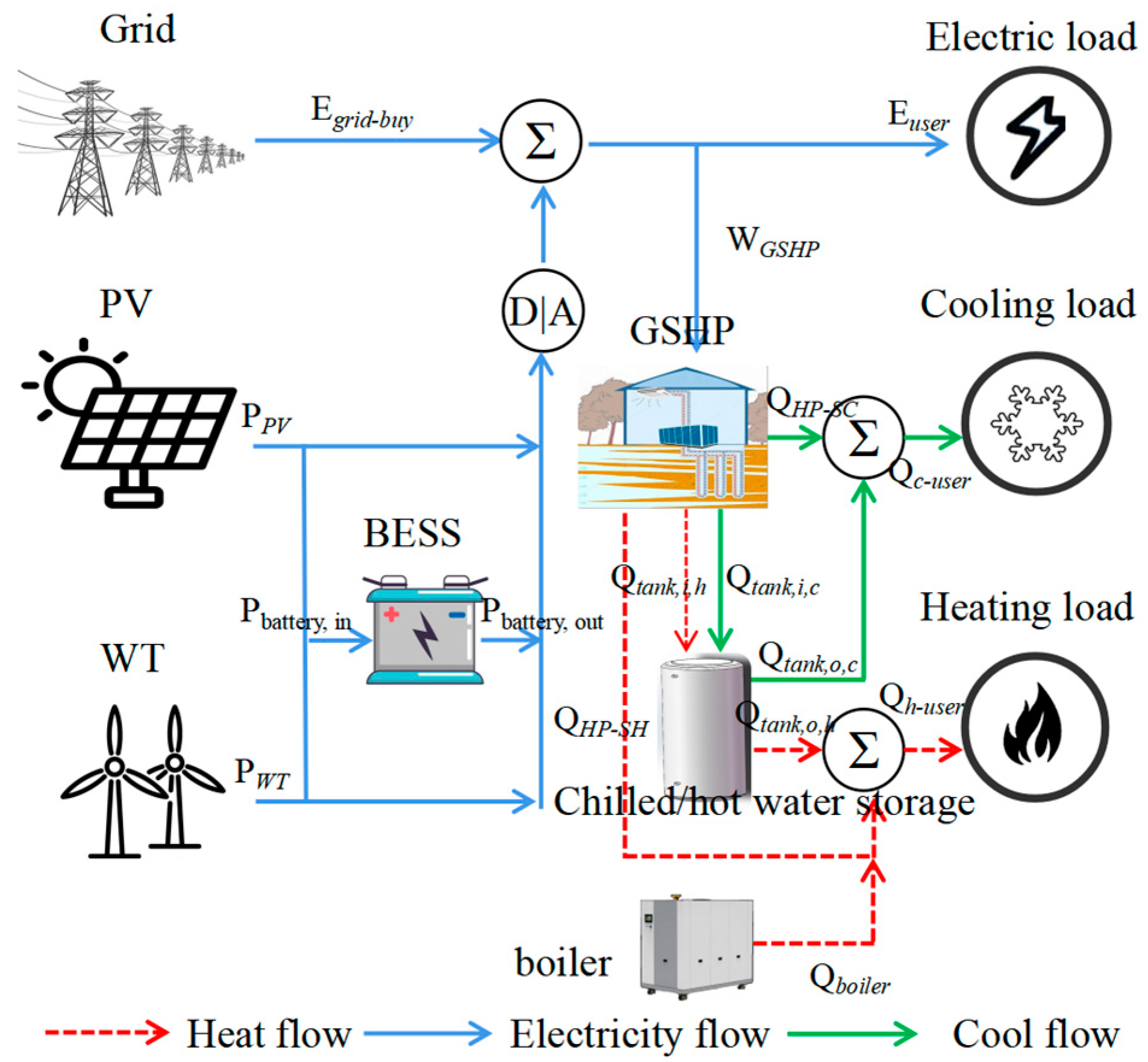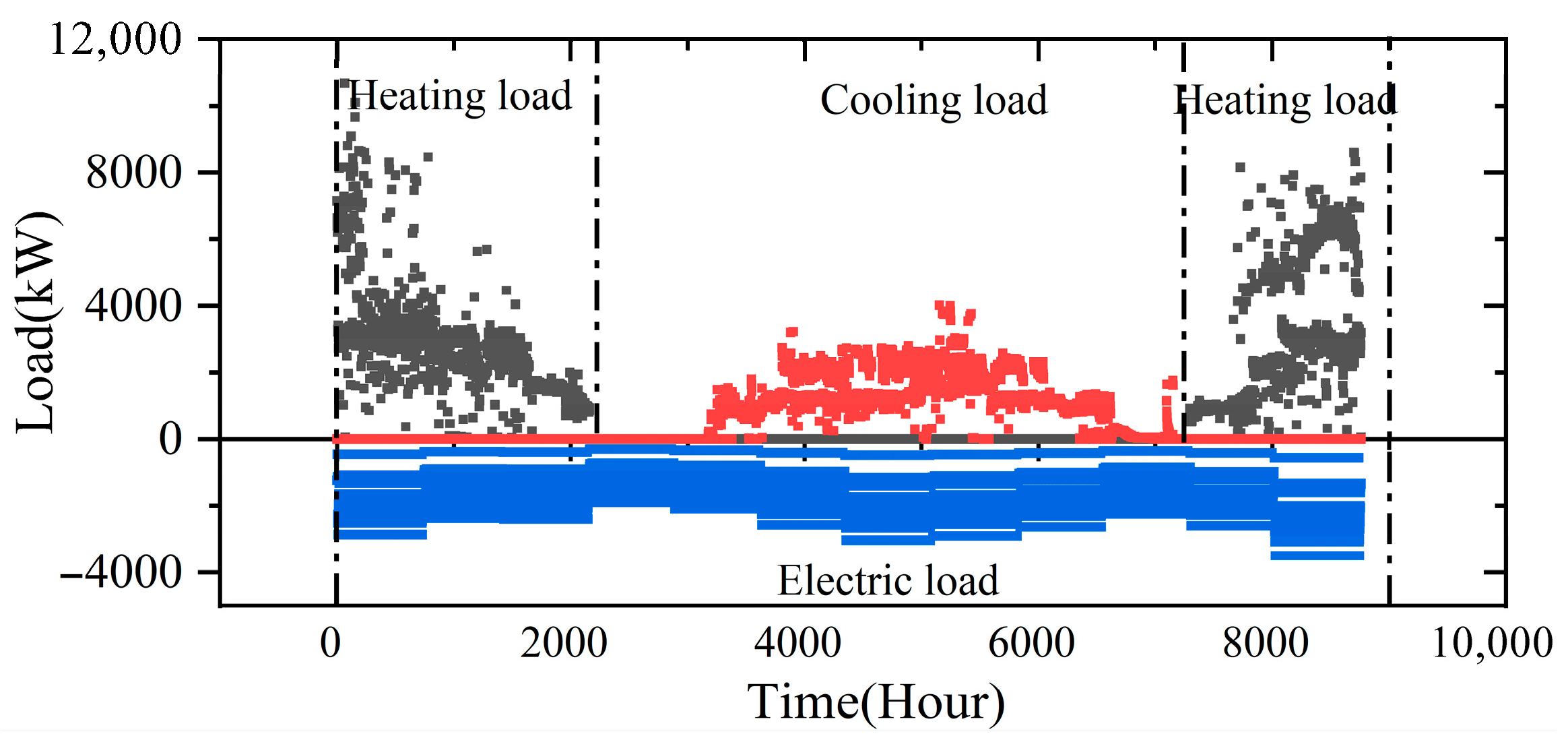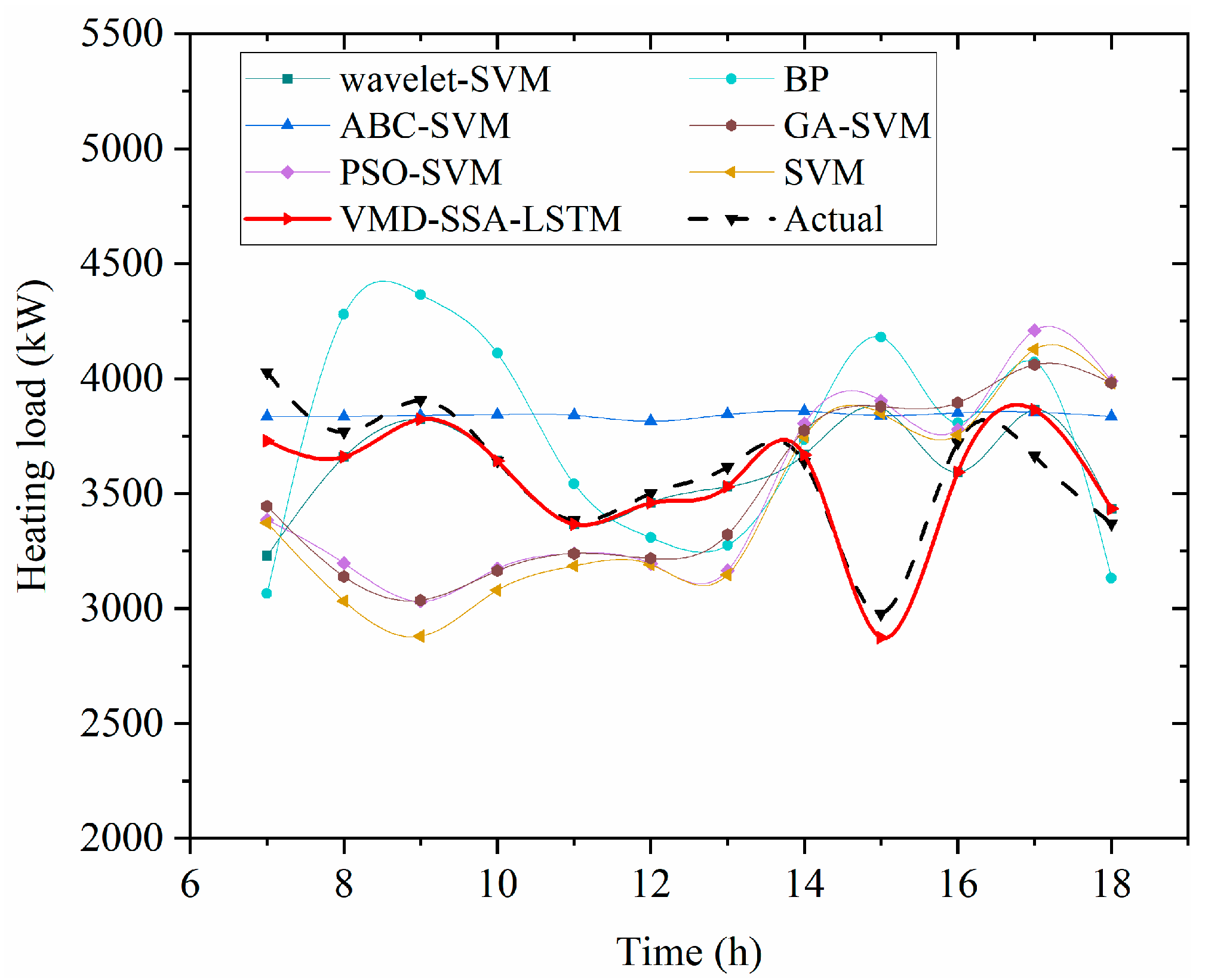1. Introduction
With accelerating global urbanization, energy demand across industry, transport, buildings, and residential sectors continues to rise, bringing energy consumption issues to the fore. According to the International Energy Agency, the building sector accounts for roughly 30% of global final energy use. Driven by the rapid electrification of end uses such as heating and cooling, electricity demand in buildings is expected to increase by about 35% from 2020 to 2050, and electricity is likely to become the dominant energy carrier in this sector, reaching around two-thirds of total energy consumption [
1]. However, a primary energy mix dominated by oil, natural gas, and coal entails environmental pollution and greenhouse gas emissions, exacerbating climate change and ecological stress. Under the dual pressures of resource constraints and environmental requirements, the energy system is accelerating its transition toward clean, low-carbon, and renewable pathways [
2].
As a key component of the modern energy internet, the IESs coordinate multiple energy carriers through multi-energy coupling and intelligent scheduling, enabling efficient allocation across energy forms and time scales with notable environmental and economic benefits. In load-intensive scenarios such as parks and industrial parks, IES not only improves on-site energy efficiency but also enhances bulk-grid stability via bidirectional interaction with the power system [
3]. Compared with traditionally siloed electricity–heat–gas systems, IESs better meets diversified energy demands and increase renewable-energy accommodation. IES technologies have received wide attention and policy support in more than 80 countries, including the United States [
4], Canada [
5,
6], the European Union [
7,
8,
9], and Japan [
10]. Since 2015, China has accelerated research and demonstrations, advancing smart-energy platforms and multi-energy complementarity in various parks under the dual-carbon targets [
11]. Nevertheless, park-level IESs still face strong multi-energy coupling, multi-objective trade-offs, and scenario heterogeneity, for which existing models struggle to deliver fine-grained performance.
With high penetration of renewable energy sources such as wind and photovoltaics (PV), both load and generation exhibit stronger uncertainty and volatility, further complicating supply–demand matching and optimal scheduling. To address uncertainty, distributed robust co-scheduling has been proposed to enhance the coordination of multi-region IESs under wind and load uncertainties [
12]. On the demand-response (DR) side, multi-timescale, response-aware game-theoretic scheduling has been developed to improve responsiveness to load fluctuations [
13]. From the perspectives of user autonomy and multi-energy synergy, multilevel distributed DR and integrated benefit-optimization models have been reported, providing theoretical support for efficient scheduling under complex loads [
14,
15]. However, under high renewable penetration, relying solely on scheduling and DR is insufficient for real-time balancing. High-accuracy forecasting of diversified loads—particularly cooling and heating—becomes pivotal to improving dispatch precision and flexibility. Load forecasting not only helps depict intrinsic multi-energy couplings but also provides data foundations for system optimization and coordinated multi-energy scheduling, thereby improving energy efficiency and alleviating local supply–demand tensions [
16].
In recent years, swarm-intelligence algorithms—such as particle swarm optimization (PSO) [
17], the whale optimization algorithm (WOA) [
18], the SSA [
19], and dung beetle optimization (DBO) [
20]—have been widely employed to improve load-forecasting accuracy, often integrated with LSTMs with attention mechanisms and support vector regression (SVR), demonstrating strong modeling and generalization capabilities [
21]. To overcome heuristic algorithms’ tendencies to become trapped in local optima and converge slowly, strategies such as chaotic mechanisms, elitist opposition-based learning, and reverse learning have been introduced, significantly enhancing global search capabilities [
20]. Consequently, high-performance load forecasting has become a core enabler for addressing IES scheduling challenges and ensuring secure, economic operation.
Meanwhile, deep interaction between IESs and the power grid has become an important direction in modern energy-system evolution. Through buy–sell electricity mechanisms, IESs can realize bidirectional energy flows and flexible load adjustments, while providing ancillary services such as peak shaving and valley filling for the grid [
22]. As a key grid-side instrument, DR guides users to adjust consumption during peak or stress periods, increasing flexibility and responsiveness, facilitating renewable integration, and easing grid stress [
23]. Park-level IESs, via coordinated scheduling, can achieve higher-level load-side management across electricity–heat–cooling–gas dimensions, advancing the energy internet and jointly improving system reliability and economic performance.
Conventional buy–sell strategies primarily rely on day-ahead scheduling (DAS), typically minimizing procurement costs [
24] and maximizing economic benefits [
12,
13,
14,
25] based on load and price forecasts. With the deepening application of DR, loads can be flexibly adjusted following grid signals, markedly enhancing adaptability to renewable variability. Integrated DR models covering cooling, heating, electricity, and natural gas have been shown to improve system flexibility and energy efficiency [
15]. Studies indicate that transferable loads under DR help shave peaks, fill valleys, and reduce operating costs [
26]. However, for large energy consumers such as parks, single-mode DR alone can hardly unlock the full flexibility potential. Leveraging multi-energy coupling to establish deep, coordinated interactions with the grid has become essential to ensure reliability, economic efficiency, and sustainability. Accordingly, diverse objectives—e.g., improving grid responsiveness [
27], smoothing load fluctuations [
28], and reducing peak–valley gaps [
29]—have been formulated to guide the coordinated optimization of IESs and achieve efficient grid interactions, thereby laying a theoretical foundation for enhancing park energy efficiency and supporting low-carbon transitions.
Under the current research context, the literature addressing multi-energy carriers, park-scale load forecasting, and energy-system optimization has grown progressively. However, existing work often focuses on single-energy coupling (e.g., electricity–heat or electricity–gas) or on limited park settings, and lacks systematic, cross-type comparisons of forecasting accuracy, scheduling performance, and economic outcomes across diverse park types [
12,
13,
14,
15,
21,
22,
23,
24,
25,
26,
27,
28,
29,
30]. Although recent reviews have cataloged forecasting techniques from traditional time series to deep learning and have surveyed multi-time-scale optimization and multi-energy coordination approaches (including day-ahead and real-time horizons), there remains a gap in directly benchmarking these methods within a unified park-level IES framework to enable meaningful cross-study comparisons [
12,
13,
14,
15,
23,
24,
25,
26,
27,
28]. Addressing this benchmarking gap is critical, as the literature increasingly recognizes that robust park-level coordination requires not only accurate predictions but also end-to-end optimization that accounts for the interdependencies and couplings among electricity, heating, cooling, and storage, thereby delivering more comprehensive economic and environmental benefits [
12,
13,
14,
15,
21,
22,
23,
24,
25,
26,
27,
28,
29,
30,
31].
Overall, under ongoing energy transition and dual-carbon targets, park-level IESs play an increasingly vital role in multi-energy complementarity, energy-efficiency improvement, and clean, low-carbon development. Yet, strong volatility and high uncertainty on the load side challenge traditional historical data-based operation methods, which fall short of fine-grained, smart operation and management needs. The accuracy of load forecasting directly influences the economic efficiency and security of dispatch. Thus, a central research challenge is the deep integration of high-accuracy load forecasting with coordinated multi-energy optimization to enable efficient source–load integrated scheduling for park-level IESs, coupled with robust evaluation frameworks that can compare forecasting accuracy, scheduling outcomes, and economic performance across diverse park contexts.
The main contributions are as follows:
A cooling–heating load-forecasting model is proposed that integrates Pearson correlation analysis, VMD, and SSA-LSTM. Correlation-based feature screening, signal decomposition for nonstationary, multi-scale characteristics, and swarm-intelligence-based hyperparameter tuning jointly improve forecasting accuracy and generalization.
A day-ahead optimal scheduling model for park-level IESs is established, oriented to multi-energy coupling and grid interaction. The model co-optimizes load-side objectives/constraints, device coordination, and flexible grid interactions, jointly reducing operating costs and external-grid impact to enhance system flexibility and adaptability.
Using real energy-consumption data from an office park, simulation studies verify the effectiveness and practicality of the proposed methods. Results indicate that the forecasting model significantly improves accuracy, while the scheduling model reduces operating costs and strengthens renewable-energy accommodation.
5. Conclusions
5.1. Main Findings
This article addresses the optimal scheduling of a park-level IES and proposes a scheduling optimization framework that integrates cooling/heating load forecasting with grid-interaction characteristics, followed by systematic validation. First, through a comprehensive correlation analysis between multiple influencing factors and the cooling/heating loads, historical load, ambient temperature, and relative humidity are identified as the primary drivers of load variation. Based on this insight, a high-accuracy load forecasting model is constructed using temperature, relative humidity, and historical load as inputs. The results show that advanced data-driven methods such as the VMD-SSA-LSTM can markedly improve the accuracy of cooling/heating load forecasting. The MAPE for the office park is 8.32% for cooling load and 5.8% for heating load, both outperforming conventional methods
Building on the forecasts, two day-ahead scheduling strategies—one based on historical load curves and the other on forecasted loads—are analyzed and compared. In representative heating and cooling season case studies, the forecast-driven optimization strategy exhibits a clear advantage, reducing the standard deviation of purchased electricity by 29.6–88.1%. Specifically, in the heating season, the post-optimization standard deviations for three representative days are 44.6 kW, 82.7 kW, and 23.8 kW, substantially lower than the pre-optimization values of 108.8 kW, 117.6 kW, and 130.95 kW. In the cooling season, the corresponding post-optimization values are 41.5 kW, 77.0 kW, and 22.7 kW, compared with 194.2 kW, 318.7 kW, and 202.9 kW before optimization. Moreover, forecast-based scheduling yields system operating cost savings of 6.4–15.1% in the heating season and 3.8–11.6% in the cooling season.
In summary, this work demonstrates that the proposed optimization framework—grounded in cooling/heating load forecasting and grid interaction—significantly enhances the stability, economic performance, and flexibility of the park-level IES. The method effectively addresses scheduling challenges arising from multi-energy coordination and load uncertainty, and it shows strong potential for engineering deployment and academic innovation. It provides a solid theoretical foundation and practical reference for the optimal dispatch of future park-level IESs.
5.2. Limitations and Future Work
Despite the encouraging results, several limitations remain. First, the current simulation model of the IES provides an insufficient representation of the thermal network and thus does not fully capture the complexity of energy transfer and coupling processes in real applications. Second, the load and equipment outputs are modeled with a one-hour time step and directly in terms of power, neglecting the delay and hysteresis effects inherent in cooling and heating systems. Future work should incorporate refined modeling of energy network inputs/outputs and transport characteristics to improve simulation fidelity. Third, the constraints on energy balance, energy supply, and device operation in the optimization model are relatively simplified and do not comprehensively cover the diverse constraints of multi-type supply equipment and thermal/electrical networks. Subsequent research should further refine model boundaries and constraint formulations to better align with the operational requirements of real systems.














